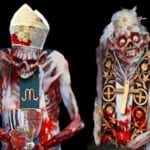 Weird Stuff
Weird Stuff  Weird Stuff
Weird Stuff  Animals
Animals 10 Inspiring Tales of Horses Being Human
 Mysteries
Mysteries Top 10 Haunting Facts About the Ghost Ship MV Alta
 History
History 10 Surprising Stories About the Texas Rangers
 Humans
Humans 10 Philosophers Who Were Driven Mad by Their Own Theories
 Miscellaneous
Miscellaneous 10 Video-Game-Worthy Weapons and Armors from History
 Weird Stuff
Weird Stuff 10 Psychics Who Accurately Predicted Wartime Events
 The Arts
The Arts 10 Pieces of Art Inspired by a Broken Heart
 Health
Health 10 Science Fiction-Sounding New Medical Treatments
 History
History 10 Surprising Facts About the Father of Submarine Warfare
 Weird Stuff
Weird Stuff 10 Times Real Laws Were Based on Bizarre Hypotheticals
 Animals
Animals 10 Inspiring Tales of Horses Being Human
 Mysteries
Mysteries Top 10 Haunting Facts About the Ghost Ship MV Alta
Who's Behind Listverse?

Jamie Frater
Head Editor
Jamie founded Listverse due to an insatiable desire to share fascinating, obscure, and bizarre facts. He has been a guest speaker on numerous national radio and television stations and is a five time published author.
More About Us History
History 10 Surprising Stories About the Texas Rangers
 Humans
Humans 10 Philosophers Who Were Driven Mad by Their Own Theories
 Miscellaneous
Miscellaneous 10 Video-Game-Worthy Weapons and Armors from History
 Weird Stuff
Weird Stuff 10 Psychics Who Accurately Predicted Wartime Events
 The Arts
The Arts 10 Pieces of Art Inspired by a Broken Heart
 Health
Health 10 Science Fiction-Sounding New Medical Treatments
 History
History 10 Surprising Facts About the Father of Submarine Warfare
Top 10 Dark Facts About Alice In Wonderland
Written by Lewis Carroll (a pseudonym of Charles Lutwidge Dodgson) in 1865, Alice’s Adventures in Wonderland is without a doubt one of the most enduring childhood tales of all time. Endlessly adapted for film, the famous Victorian-era children’s novel contains some of literature’s most entertaining and memorable characters, from the dotty Mad Hatter to a White Rabbit obsessed with being on time.
For all its charm and warmth, however, here are some perspectives, facts and theories which may cast a much grimmer light on this beloved childhood favourite.
Top 10 Darkest Secrets Of Coca-cola
10 The text contains multiple jokes about death
Bright and whimsical as the novel appears, it actually features a number of lines which suggest a grisly demise. Alice persistently finds herself in situations in which she risks death, whether drinking from a bottle that potentially contains poison or being beheaded by a bloodthirsty queen. Literary scholars Martin Gardner and William Empson[1] point out that while some demand reading between the lines, others are more obvious.
The first takes place when during Alice’s fall down the rabbit hole and suggests tumbling off the top of a roof:[2] “‘Well!’ thought Alice to herself. ‘After such a fall as this, I shall think nothing of tumbling down-stairs! How brave they’ll all think me at home! Why, I wouldn’t say anything about it, even if I fell off the top of the house!’ (Which was very likely true.)”
9 Many characters personify mental conditions
It’s no coincidence that one of the novel’s most famous lines, “we’re all mad here”, is one of the most enduring. At the time of publication of Carroll’s work, mental health was not yet properly understood, leading to many mentally ill individuals being branded as ‘mad’ and confined to mental asylums.[3]
The conditions[4] seemingly illustrated by Carroll include eating disorders (reflected in Alice’s constant eating and drinking only to regret her consumption later on), borderline personality disorder (the Mad Hatter’s rapid and unsettling shifts in mood at the famous tea party) and even general anxiety disorder (the White Rabbit obsessing over punctuality and terrified of being late).
The text is apparently so infused with a strain of mental illness that there’s even a syndrome named after it: Alice in Wonderland syndrome, a condition of disorientation which affects size perception, and from which Carroll was speculated to suffer.[5]
8 Deadly Life Lessons
Alice in Wonderland contains many life-lessons parents would consider essential in the upbringing of their children. But you won’t find any lessons that warn against not looking both ways when you cross the street or not to play with fire. Instead, the lessons readers learn through Alice are far more… realistically life-threatening. Making things even grimmer is the implication that a failure to listen to certain rules laid down by adults will almost certainly result in death.
Alice’s testing the contents of an unmarked bottle bring these teachings to the fore:[6]
“She had read several nice little histories about children who had got burnt, and eaten up by wild beasts and other unpleasant things, all because they would not remember the simple rules their friends had taught them: such as, that a red-hot poker will burn you if you hold it too long; and that if you cut your finger very deeply with a knife, it usually bleeds; and she had never forgotten that, if you drink much from a bottle marked “poison,” it is almost certain to disagree with you, sooner or later.”
These ‘nice little stories’ are not entirely out of the ordinary, however. Traditional fairy tales are actually filled with horror and death and usually feature a moral at their close, something the watered-down versions we know of today have done away with. As Gardener explains,[7] however, Carroll opened up a new space by creating a genre which doesn’t include the moral but retained the grisly realism.
7 The Mad Hatter and mercury poisoning
In Carroll’s day, the expression “mad as a hatter” was very common and could well have informed the mentally unstable nature of his beloved character, who may have suffered as a result of his hat-making profession. Mercury was used in Medieval-European medicine and manufacturing, and at a later point in time, hat makers commonly cured felt for their craft using a form of mercury called mercurous nitrate.[8] Over time, they would inhale the toxic vapours and often suffer from neurological symptoms of mercury poisoning, perceived by some as a form of madness. According to Gardner, victims would frequently develop a tremor known as “hatter’s shakes” (affecting their eyes and limbs) and would later develop hallucinations.
6 Wonderland is engorged with sexual symbolism
Many readers and critics have picked up a strong invocation of sexual themes between the lines of the beloved children’s classic.[9] In her essay, “Curious Appetites”, Carina Garland argues that Alice experiences something of a sexual awakening in the narrative, breaking free of the limitations previously imposed on her and “emphasises the notion of vagina dentata”,[10] becoming a violent female personality who takes control of her desires. She rebels against male-dominance, Garland argues, countering the male dominance of the hero of the Jabberwocky poem who uses his masculinity and revered sword (a phallic symbol) to kill the dragon, which is “symbolic of female sexual desire.”
In his “Some Versions of the Pastoral”, Empson maintains that gynaecological imagery is a key part of the text, seeing in Alice’s arrival in Wonderland a form of birth, writing that she “runs the whole gamut; she is a father in getting down the hole, a foetus at the bottom, and can only be born by becoming a mother and producing her own amniotic fluid.”[11]
10 Depressing Truths About Modern Medicine
5 Carroll may have had paedophilic tendencies
The sexual bent of the text may be a result of the child-obsession of its author. It’s commonly accepted that Carroll composed the classic tale for the Liddell sisters, the children of a friend and colleague, Henry Liddell. Fond of picnicking with these young girls, Carroll took them out one day on the Thames in July 1862 and told them a story that would become the acclaimed work (he even named his protagonist after one of the girls, Alice).[12]
Although initially believed completely innocent, Carroll’s obsessive relationship with children has come under scrutiny in recent years.[13] Beyond interacting frequently with young children, he was also known for talking photos of them. Of 3,000 photo¬graphs Carroll took in his lifetime, over half are of children, some of whom are shown nude or semi-nude. While many continue to argue that the author was simply a saint-like lover of youth (citing the lack of any evidence of actual wrongdoing), others have found his interest in children a tad discomforting.
4 Alice in Drug Land?
Over the years, Alice in Wonderland has repeatedly been read as an ode to drug and substance abuse. The novel and its subsequent film adaptations feature a great deal of potion drinking, mushroom eating and hallucinations, to say nothing of the rapid changes in reality and even a hookah-smoking caterpillar.
This belief was only strengthened in 1967 with Jefferson Airplane’s release of the psychedelic song, White Rabbit, in which the lyrics include “One pill makes you larger, and one pill makes you small / And the ones that mother gives you, don’t do anything at all”.[14] The song proved enormously popular and inspired several artists to pursue the link between Alice and recreational drugs, such that Carrol’s character was essentially the mascot of drug culture in the 1960s.[14] So strong was the association that author Scott Parker points out that Alice had become a slang term for LSD.
The novel’s weird whimsy has led many to question whether Carroll was under the influence while writing the text, and despite the drug-driven elements of the narrative, no evidence has been found to support the claim.
3 A Children’s Book on Colonialism
Alice’s travels to a land quite unlike Victorian England, and her encounters with apparently nonsensical people and customs have been read as a commentary on the British colonialist project. In casting the Queen of Hearts in a somewhat domineering and at times aggressive light, some have argued that Carroll didn’t think too highly of the reigning monarch, Queen Victoria[16] (Empson goes so far as to say that “it is an obvious bit of interpretation to say that the Queen is a symbol for uncontrolled animal passion”).
According to researcher Amanda Bryan, Carroll’s story can be read as subtly critiquing British colonialism within the imperialist context.[17] She suggests that each of the novel’s chapters provide adventures and imagery which illustrate the harmful dimensions of imperial projects and colonial fixations on the part of the British.
She writes: “In this vein, the Queen of Hearts would be synonymous with Queen Victoria; Alice becomes a surrogate for indigenous populations residing in English colonies; and the Mad Tea Party mirrors the British East India Company. Children’s fantasy and seeming ‘nonsense’ provided Carroll a vehicle for delivering his critiques.”
2 A Childhood Story About the Loss of Childhood
Alice’s exploration of Wonderland includes a great deal of emotional upheaval, irresolvable questions and enduring frustration. Coupled with her extreme changes in size and the discomfort her size causes her (a standard experience of those going through puberty ),it has been suggested that where Alice goes is less of a wondrous land than a psychological plane on which she loses her naivete and grows up.
Scholar James Kincaid[18] has suggested that Alice is an adolescent constantly asking: “Who in the world am I?” who wants desperately to grow up and leave her foolish childhood behind. She betrays her innocence, pushing to mature faster than she should, and is shown up time and again by situations and characters that prove to her she should rather remain a child for as long as possible instead of hastening to enter a cruel, confusing and often violent world. The book, says Kincaid, “is about growing up, and recognizes both the melancholy of the loss of Eden and the child’s rude and tragic haste to leave its innocence.”
1 Nihilism: life doesn’t always have meaning
Overall, perhaps Alice in Wonderland’s narrative offers one the most unsettling and darkest perspectives of them all: nothing means anything. From beginning to end, Alice’s exploration of Wonderland is full of misunderstanding, illogical questions and the enduring power of chaos. When Alice attempts to play croquet with the Queen of Hearts, she finds that the game makes almost no sense whatsoever, armed with a live flamingo for a mallet that cannot keep still, live hedgehogs as balls and a rule system that changes to suit the whims of a vicious Queen (who at every juncture threatens to behead her subjects).
As Alvin C. Kiebel finds,[19] few rules apply across Wonderland, either physically or figuratively. The laws of Physics are cast aside by a Queen running to remain in one place, and even language rules are endlessly twisted to suit the whims of anyone speaking. As Humpty Dumpty says to Alice: ‘When I use a word, ‘it means just what I choose it to’, later adding about words themselves that ‘they’ve a temper, some of them—particularly verbs, they’re the proudest—adjectives you can do anything with, but not verbs’. The novel’s famous poem, The Jabberwocky, features plenty of made-up words, be it the time of ‘brillig’, the description of the ‘slithy toves’, or the fact that the ‘mome raths outgrabe’.[20]
The strange sounds of these nonsense words confuse all grammar and lexical rules, perhaps scarily suggesting that life’s meaning, like the meaning of the text overall, is only what we make of it.
Top 10 Gruesome Fairy Tale Origins
About The Author: Writer, journalist and English academic.
![Top 10 Dark Facts About The Death Penalty [DISTURBING] Top 10 Dark Facts About The Death Penalty [DISTURBING]](https://listverse.com/wp-content/uploads/2020/06/deathpenalty-150x150.jpg)




![9 Sinister Facts About The Dark Side Of Instagram [WARNING: Disturbing] 9 Sinister Facts About The Dark Side Of Instagram [WARNING: Disturbing]](https://listverse.com/wp-content/uploads/2019/10/proxy.duckduckgo-150x150.jpg)


